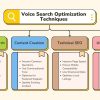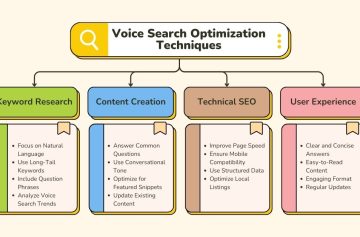In today’s competitive digital landscape, local SEO tips for small businesses need more than just a good product or service to stand out—they need visibility. Local SEO (Search Engine Optimization) is the secret weapon that enables small businesses to connect with nearby customers and build a loyal community. By optimizing for local search, businesses can appear in search results precisely when customers are searching for the services or products they offer.
Importance of Local SEO for Small Businesses
Local SEO is critical for small businesses aiming to thrive in their local markets. Unlike traditional SEO, which targets a broader audience, local SEO focuses on a specific geographic area, making it ideal for businesses like restaurants, salons, retail shops, or service providers. With the rise of mobile searches and “near me” queries, local SEO has become indispensable for:
- Driving Foot Traffic: Appearing in local search results increases the chances of customers visiting your physical store.
- Building Brand Awareness Locally: Regular visibility in local search results helps establish your business as a trusted name in the community.
- Boosting Conversions: Customers searching for local businesses often have high purchase intent, leading to more inquiries and sales.
How Local SEO Helps Attract Nearby Customers
Local SEO connects small businesses with potential customers who are nearby and actively searching for their offerings. Key features like Google’s Local Pack, Google Maps, and local search results ensure businesses are visible at the right time and place. For example:
- “Near Me” Searches: Queries like “best pizza near me” are now a common part of everyday consumer behavior.
- Mobile-Friendly Results: With a growing number of people using smartphones to find businesses on the go, local SEO ensures small businesses show up prominently for mobile searches.
- Community Engagement: Local SEO helps businesses become a part of their community by promoting local events, gathering reviews, and engaging with customers.
Overview of the Actionable Tips Covered in the Article
This article explores 15 proven local SEO tips tailored to help small businesses enhance their online presence and attract more local customers. From optimizing your Google Business Profile to leveraging local keywords and building customer reviews, these strategies are easy to implement and effective in boosting visibility. Whether you’re a new business or looking to improve your existing efforts, these tips will provide a roadmap to dominating local search rankings in 2024.
Stay tuned as we guide you through actionable steps that will help you connect with your local audience, drive more traffic, and grow your business.
What is Local SEO and Why is it Important for Small Businesses?
Local SEO (Search Engine Optimization) is a crucial digital marketing strategy for small businesses aiming to connect with customers in their immediate area. By optimizing for local search, businesses can improve their visibility on search engines and attract nearby customers actively searching for products or services.
Defining Local SEO and How It Works
Local SEO is a specialized branch of SEO that focuses on improving a business’s online visibility in localized search results. It ensures that your business appears in search queries with local intent, such as “near me” or “in [city name].”
Key elements of local SEO include:
- Google Business Profile Optimization: Enhancing your profile to appear in the local pack and Google Maps.
- Local Keywords: Incorporating geographically targeted keywords in your content and metadata.
- NAP Consistency: Ensuring your Name, Address, and Phone Number (NAP) are consistent across all online directories.
How It Works: Search engines use a combination of relevance, distance, and prominence to determine which businesses appear in local search results. By signaling these factors effectively, you can secure a top spot in the local pack, increase clicks, and drive foot traffic to your business.
The Impact of Local SEO on Small Business Growth
Local SEO directly impacts small businesses by boosting visibility, credibility, and engagement within their community. Here’s how it drives growth:
- Increased Foot Traffic: local SEO tips for small businesses helps customers discover your business when searching for services in their area, leading to more in-store visits.
- Higher Conversion Rates: Customers performing local searches typically have higher purchase intent, meaning they’re more likely to become paying customers.
- Improved Trust and Credibility: Businesses that appear in the local pack with strong reviews and accurate information build trust with potential customers.
- Cost-Effective Marketing: Compared to traditional advertising, local SEO delivers sustained visibility with a smaller investment, making it perfect for small business budgets.
Common Misconceptions About Local SEO
Many small business owners have misconceptions about local SEO that prevent them from fully leveraging its potential. Let’s debunk some of the most common myths:
- “Local SEO is Only for Big Cities”: Local SEO benefits businesses in both urban and rural areas by targeting specific local audiences.
- “It’s Only for Physical Stores”: Even service-based businesses without a storefront can benefit by optimizing for their service areas.
- “I Only Need to Optimize Once”: Local SEO is an ongoing process. Regular updates, consistent reviews, and engagement are necessary to maintain rankings.
- “Reviews Don’t Matter”: Reviews significantly impact local rankings and customer trust. Ignoring reviews is a missed opportunity to enhance credibility.
By understanding what local SEO tips for small businesses is, how it works, and its significant impact, small businesses can prioritize this strategy to ensure sustainable growth and long-term success in their local markets.

Image Source Credit: Pexels.com
15 Local SEO Tips for Small Businesses
Implementing effective local SEO strategies is essential for small businesses to connect with their local audience and dominate search results. Here are 15 actionable tips to boost your local SEO efforts and drive results.
1. Optimize Your Google Business Profile
- Steps to Claim and Verify Your Google Business Profile: Visit the Google Business Profile site, claim your business, and verify it through a postcard, email, or phone.
- How to Add Accurate Information and Update Regularly: Ensure your business name, address, phone number (NAP), operating hours, and services are accurate. Regularly update photos, respond to reviews, and post updates to keep your profile active.
2. Focus on Local Keywords
- Tools for Finding Geo-Targeted Keywords: Use tools like Google Keyword Planner, Ahrefs, or SEMrush to identify keywords with local intent, such as “best bakery in [city].”
- Incorporating Local Keywords into Content and Metadata: Use local keywords in titles, meta descriptions, headers, and body content without overstuffing.
3. Create Location-Specific Landing Pages
- Importance of Unique Content for Each Location: If your business serves multiple locations, create separate landing pages with tailored content for each area.
- Optimizing Location Pages for User Experience and SEO: Include maps, customer testimonials, and local keywords to make these pages user-friendly and relevant.
4. Leverage Customer Reviews and Ratings
- Encouraging Satisfied Customers to Leave Reviews: Ask happy customers for reviews via follow-up emails or QR codes in-store.
- How to Respond to Reviews to Build Trust and Engagement: Reply to all reviews, whether positive or negative, to show that you value customer feedback.
5. Use Local Business Directories
- Listing Your Business on Directories: Ensure your business is listed on platforms like Yelp, Bing Places, Yellow Pages, and industry-specific directories.
- Ensuring Consistent NAP Across Platforms: Inconsistent information can confuse search engines and customers. Keep your NAP details uniform everywhere.
6. Build Local Backlinks
- Partnering with Local Businesses for Backlinks: Collaborate with nearby businesses, sponsor local events, or participate in community activities to earn backlinks.
- Writing Guest Blogs for Community Websites: Contribute valuable content to local blogs or news sites to gain exposure and build authority.
7. Optimize for Voice Search
- Understanding Voice Search Behavior and Queries: Voice searches are often phrased as questions (e.g., “Where’s the best coffee shop near me?”).
- Adapting Content to Match Conversational Language: Use natural language and question-based headings in your content to align with voice search queries.
8. Create Locally Relevant Content
- Writing About Local Events, News, and Topics: Share blog posts or social media updates on events happening in your community.
- Sharing Behind-the-Scenes Stories: Showcase your team, highlight local collaborations, or post updates that connect your business to the local culture.
9. Add Schema Markup
- Benefits of Local Schema for Small Businesses: Schema markup helps search engines understand your content better, increasing your chances of appearing in rich snippets.
- Implementing Schema for Reviews, Locations, and Events: Use schema to highlight customer reviews, business hours, and special events in search results.
10. Improve Mobile Usability
- Importance of Mobile-First Indexing for Local SEO: With mobile-first indexing, Google prioritizes mobile-friendly websites for rankings.
- Tools to Check and Improve Mobile-Friendliness: Use tools like Google’s Mobile-Friendly Test and Lighthouse to identify and fix issues.
11. Focus on Local Social Media Engagement
- Connecting with Your Community: Engage with local customers through platforms like Facebook, Instagram, and Twitter. Join community groups to increase visibility.
- Promoting Offers and Updates: Tailor promotions to local events or holidays and share them on your social channels.
12. Use Geotagged Photos
- Adding Geotags to Images: Add location data to your photos before uploading them to your website or Google Business Profile.
- Best Practices for Image Optimization: Compress images for faster loading and include descriptive filenames and alt tags with local keywords.
13. Monitor Competitor Strategies
- How to Analyze Your Competitors’ Local SEO Tactics: Use tools like SEMrush or Ahrefs to study competitors’ keywords, backlinks, and content.
- Learning from Their Strengths: Identify what works for them and adapt those strategies for your business.
14. Track and Measure Local SEO Performance
- Tools for Tracking Local SEO Results: Use Google Analytics to track traffic and Google My Business insights to measure profile performance.
- Adjusting Strategies Based on Insights: Regularly review data to identify strengths and weaknesses and adapt accordingly.
15. Stay Updated on Local SEO Trends
- Following SEO Blogs and Resources: Stay informed by reading reputable SEO sites like Moz, Search Engine Journal, or Neil Patel’s blog.
- How Algorithm Changes Impact Local Rankings: Be aware of updates to Google’s algorithm to adjust your strategies and maintain rankings.
By implementing these 15 tips, small businesses can significantly improve their local search visibility, attract more customers, and establish a strong presence in their community.
Common Local SEO Mistakes to Avoid
Even with a solid local SEO strategy, small businesses can inadvertently make mistakes that hinder their visibility and growth. Avoiding these common pitfalls is essential to ensure your efforts lead to better rankings, increased traffic, and more customers.
Ignoring Mobile Optimization
- Why It’s a Mistake: With most local searches now happening on mobile devices, having a non-optimized or poorly performing mobile website can drive potential customers away.
- Impact on Rankings and User Experience: Google prioritizes mobile-friendly websites through mobile-first indexing. A slow or unresponsive mobile site can lead to lower rankings and higher bounce rates.
- How to Avoid It:
- Use tools like Google’s Mobile-Friendly Test to assess your site’s performance.
- Ensure your website is responsive, meaning it adapts seamlessly to different screen sizes.
- Optimize loading speeds by compressing images, minimizing code, and enabling browser caching.
Inconsistent NAP Across Platforms
- What It Means: NAP stands for Name, Address, and Phone Number. Inconsistent details across directories and listings confuse both search engines and potential customers.
- Why It’s Harmful: Search engines rely on consistent NAP information to verify a business’s legitimacy. Discrepancies can hurt local rankings and erode customer trust.
- How to Avoid It:
- Audit all your listings on platforms like Google Business Profile, Yelp, Bing Places, and social media profiles.
- Use tools like Moz Local or BrightLocal to ensure consistency across platforms.
- Keep your information updated if you change your business name, address, or phone number.
Neglecting Customer Reviews and Feedback
- Why It’s a Mistake: Reviews significantly influence local rankings and customer decisions. Ignoring them can cost you valuable opportunities to build trust and engage with your audience.
- Impact on Business Growth: A lack of reviews—or worse, negative reviews that go unanswered—can deter potential customers and make your business seem unresponsive or unreliable.
- How to Avoid It:
- Actively encourage satisfied customers to leave reviews on platforms like Google, Yelp, and Facebook.
- Respond to all reviews—both positive and negative—with gratitude and professionalism. For example, thank happy customers and address concerns raised in negative reviews.
- Highlight positive reviews in your marketing efforts to build credibility and attract more customers.
By prioritizing mobile optimization, maintaining consistent NAP details, and actively engaging with customer reviews, small businesses can avoid common mistakes that undermine their local SEO efforts. These practices ensure your business not only ranks higher but also builds trust and loyalty within your community.
Conclusion
local SEO tips for small businesses is a game-changer for small businesses looking to enhance their online presence and connect with nearby customers. By focusing on strategies tailored to local search, businesses can improve their visibility, build credibility, and drive both online and in-store traffic.
Recap of the 15 Tips for Improving Local SEO
To summarize, here are the 15 actionable tips for boosting your local SEO:
- Optimize Your Google Business Profile – Keep it accurate and updated.
- Focus on Local Keywords – Use geo-targeted keywords in your content and metadata.
- Create Location-Specific Landing Pages – Tailor content for each service area.
- Leverage Customer Reviews and Ratings – Encourage reviews and engage with feedback.
- Use Local Business Directories – List your business on relevant platforms with consistent NAP.
- Build Local Backlinks – Partner with local businesses and write guest blogs.
- Optimize for Voice Search – Adapt content for conversational, question-based queries.
- Create Locally Relevant Content – Highlight local events and community stories.
- Add Schema Markup – Implement structured data for better search visibility.
- Improve Mobile Usability – Ensure your site is mobile-friendly and responsive.
- Focus on Local Social Media Engagement – Connect with your community on social platforms.
- Use Geotagged Photos – Add location data to your images for better relevance.
- Monitor Competitor Strategies – Learn from your competitors’ successful tactics.
- Track and Measure Local SEO Performance – Use analytics tools to refine your strategies.
- Stay Updated on Local SEO Trends – Follow SEO updates to maintain an edge.
Encouragement to Start Implementing These Strategies Today
Taking the first step toward improving local SEO tips for small businesses doesn’t have to be overwhelming. Begin with the basics—claim your Google Business Profile, optimize your website for mobile, and encourage customer reviews. Small, consistent efforts can yield significant results over time. Remember, local SEO is a marathon, not a sprint, and the sooner you start, the sooner you’ll see the benefits.
Call-to-Action
If you’re ready to take your local SEO efforts to the next level, we’re here to help. Contact us for professional guidance tailored to your business, or subscribe to our newsletter for regular tips, tools, and insights to keep you ahead in the local search game. Let’s work together to ensure your small business thrives in 2024 and beyond!








Add comment